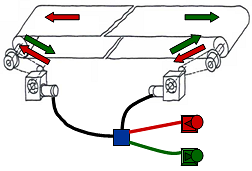Applications Cam Clutch - 10. Bidirectional conveyor
Application
Overrunning
An application to alternately repeat the conditions where the inner and outer races of the cam clutch engage to transmit the torque and where they continue spinning around depending on the difference in the rotation speed or rotation direction. The operation is the same as the free wheeling of a car.
Supporting model(s)
- ・MZ Series , etc.
Adopting machine
Bidirectional conveyor

Applications
Layout

Purpose of Use and Operation Overview
This application uses cam clutches to prevent objects from falling down on a conveyor which moves in two opposite directions as shown in the figure above. Using cam clutches allows creation of constant tension on the conveyor. When the conveyor is moved in the direction of the green arrow, drive is applied to both reducers A and B in the same direction. At this point, cam clutch A engages and moves the conveyor in the direction of the green arrow. When the conveyor is moved in the direction of the blue arrow, drive is applied to both reducers A and B in the direction opposite to the above operation. This time, cam clutch B engages and moves the conveyor in the direction of the blue arrow. When the conveyor moves in the direction of the green arrow, cam clutch A receives the load. Since cam clutch B receives no load, it rotates faster by the slip of the motor. When this occurs, a difference arises in the rotation speed between the inner and outer races of cam clutch B, and the clutch overruns. Similarly, when the conveyor moves in the direction of the blue arrow, cam clutch A overruns. As a result, the tension of the conveyor is constant all the time, preventing slack. If cam clutches are not used, the unloaded side rotates faster than the loaded side because its motor does not slip. The conveyor becomes slack and constant tension cannot be maintained. In the figure above, when the conveyor moves in the direction of the green arrow, the reducer operates the conveyor at 50 r/m via cam clutch A. Since cam clutch A receives load, the motor slips and the rotation slows down to 48.3 r/m. Although reducer B rotates at 50 r/m because it receives no load, cam clutch B prevents this rotation of 50 r/m from being transmitted to the conveyor.
When Tsubaki's cam clutches are used ・・・
It is necessary to select a cam clutch based on the mounting shaft diameter, necessary torque, rotation speed, and so on. You can select a cam clutch according to your usage conditions, sprocket model, and mounting method. Moreover, you can select a specification suited to your lubrication requirements such as high ambient temperature.
Advantage of using the cam clutch
- ・The cam clutch switches between overrunning and engagement automatically simply based on the difference in the rotation speed.
- ・Operation can be switched without the need for a device controlling overrunning and engagement.

